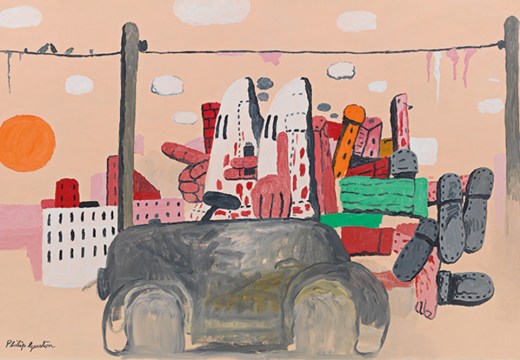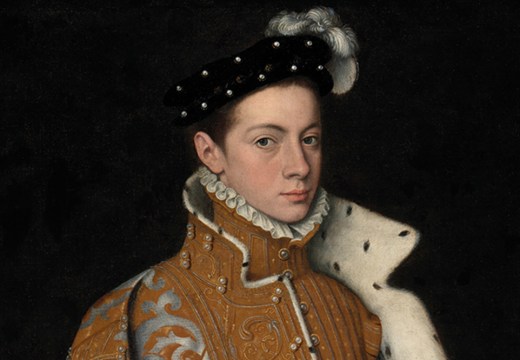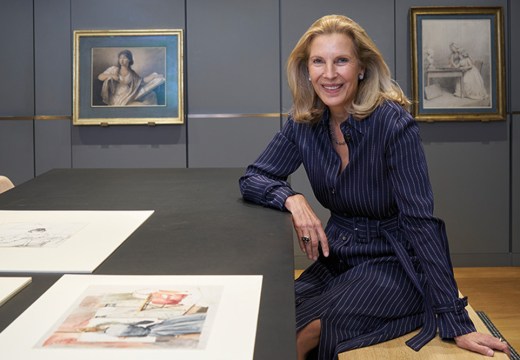From the July/August 2022 issue of Apollo. Preview and subscribe here.
In the 18th century an ‘expressive heads competition’ was launched at the Académie royale de peinture et de sculpture in honour of its former director, Charles Le Brun, court painter to Louis XIV. In Méthode pour apprendre à dessiner les passions, published posthumously in 1698, Le Brun created a lexicon of 24 emotions that explained and illustrated the proper representation of them for use by artists. Adapting the mechanics elaborated by Descartes in Passions of the Soul (1649), Le Brun portrayed a systematic vocabulary of the fleeting, volatile passions, such as hope, fear, desire, horror and rapture. The images of various expressions are far from naturalistic but their staged iconicity could be easily recognised in history painting.
Curated by art historian Dominique Lobstein, a biographer of Monet, and the historian of the emotions, Georges Vigarello, this exhibition features almost 80 works that date from the 14th century to the present day. Intending to show how the interpretation and representation of the emotions have evolved over time, it begins with a room of medieval ivories and Northern Renaissance portraits, their inert, passionless faces emblematic of nobility.
Before Le Brun, the curators argue, the features of artistic subjects remain passive; objects such as flowers, watches and skulls were used to convey emotion by association, as defined in dictionaries of symbols such as Cesare Ripa’s Iconologia (1593). There was an atmosphere of courtly restraint, where passions were thought of as turbulent invasions that had to be controlled. A copy of the Mona Lisa displays a first flicker of the emotions that would soon subsume painting, her inscrutable smile perhaps a pun on the sitter’s married name, Del Giocondo (jocund).
In the 17th century the objects associated with emotions are less numerous and the face is foregrounded as the primary indicator of feeling. Le Brun’s dictionary of the passions allowed moments of melodrama to be captured in a single, stylised and clearly recognisable image. The body became increasingly theatrical, with histrionic expressions that were easily recognisable as tragic or comic on both canvas and stage. This exaggerated aesthetic is illustrated by Simon Bernard Lenoir’s portrait of Madame Vestris (1778), portrayed as Electra in chains from Voltaire’s Oreste (1750), her eyes raised to exemplify Le Brun’s ‘rapture’; and Jean-Honoré Fragonard’s The Lock (1777), whose frenzied embrace illustrates carnal or licentious ‘desire’.
Johann Kasper Lavater, the Swiss theologian and poet, thought you could recognise character through the study of the permanent features of the face because they are marked over time by the passions. The face was a hieroglyphic text, a moral language spread over the surface of the body and legible to the skilful physiognomist.
For the 18th- and 19th-century viewer, paintings of individuals and crowds were a catalogue of distinct types, which illustrated clear moral lessons. Louis-Léopold Boilly included 35 expressive heads in a small painting (1825), each of them a distinct caricature in a theatre of pleasure, pain, terror and joy. One of these grimacing faces is the mime artist Jean-Gaspard Deburau. His son, Charles, was the subject of a series of photographs by Nadar, which show him similarly gurning for the camera.

Sainte Madeleine en pleurs (c. 1525), Maître de la Légende de Sainte Madeleine. Photo: © The National Gallery, London
While early photography followed painting in theatricalising expression, it would soon introduce a new realism and scientific rigour. Guillaume Duchenne de Boulogne, who was assisted by Nadar’s younger brother, used a constant flow of electric current to fix the muscles of the face of his laboratory subjects, so ephemeral expressions could be held long enough to be captured with the long exposure times then required in photography. Though they look like they are being tortured, the sitters had palsy, which paralysed their features, and could not feel any pain. Using electrical wands, Duchenne would use their faces as a living canvas to paint expressions and try to understand their underlying musculature. This was intended to help artists make their own representations more realistic. For example, photographs that he created when stimulating the pyramidal muscle of the nose of a dark-haired woman are intended to illustrate Lady Macbeth in a state of, by turns, moderate, strong and ferocious cruelty. They are shown alongside Charles Louis Müller’s Rachel as Lady Macbeth (1849), which depicts Shakespeare’s villain with an angst-ridden face, wringing her soiled hands.
Representations of madness were similarly bolstered by Jean-Martin Charcot and Paul Richer’s photographic work on hysteria and other pathologies at La Salpêtrière hospital. Richer was a sculptor as well as a doctor and, based on this clinical work, published Nouvelle anatomie artistique du corps humain in six volumes (1906–29).
The First World War supposedly put paid to this once universally recognisable language of expression. A photograph of a prosthetic made by the French sculptor Jane Poupelet in 1918 is displayed next to a cast of a disfigured head to illustrate how war exploded both the face and its legible meanings. This otherwise excellent exhibition rather peters out in sections devoted to 20th- and 21st-century art, which are designed to show how traumatised and alienated artists tried to ‘overcome’, ‘divert’ and ‘flee’ emotion. The exhibition ends with a return to the impassive faces with which it started: with the automata-like visages of Fernard Léger’s Trois femmes sur fond rouge (1927) and Alberto Giacometti’s sombre Grande tête (1958).
Whereas it is no doubt true that the old codes ruling how to represent expressions have broken down, this neat circularity, implying increasingly individualised and private emotions, is disappointing. In The Expression of Emotions in Man and Animals (1872), which is not mentioned here, Charles Darwin sought to break with artistic convention to represent emotions with scientific veracity and, ever since, scientists and artists have continued to grapple with and study emotions to understand what makes us human. More recently, the creation of a new grammar of emotional expressions has been key to developments in artificial intelligence, robotics and the delineation of a convincing virtual world, as well as to issues of surveillance and control. The curators might have explored numerous other avenues that would have seemed less bemused by modernity.
‘The Theatre of Emotions’ is at Musée Marmottan Monet, Paris, until 21 August.
From the July/August 2022 issue of Apollo. Preview and subscribe here
Unlimited access from just $16 every 3 months
Subscribe to get unlimited and exclusive access to the top art stories, interviews and exhibition reviews.














![Masterpiece [Re]discovery 2022. Photo: Ben Fisher Photography, courtesy of Masterpiece London](http://www.apollo-magazine.com/wp-content/uploads/2022/07/MPL2022_4263.jpg)
It’s time for the government of London to return to its rightful home